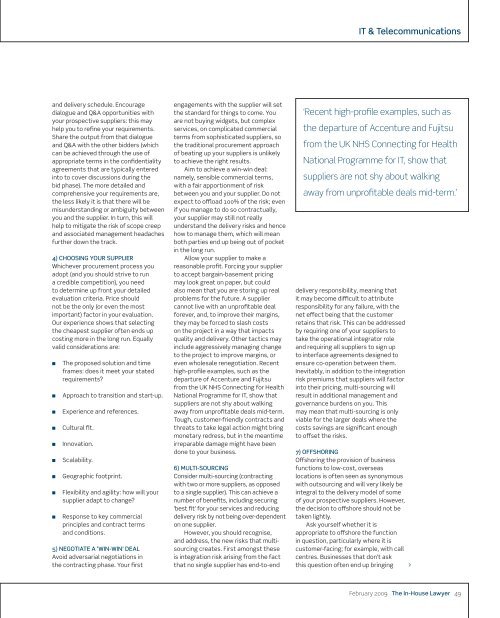Ten top tips to ensure outsourcing success - SJ Berwin
Ten top tips to ensure outsourcing success - SJ Berwin
Ten top tips to ensure outsourcing success - SJ Berwin
Create successful ePaper yourself
Turn your PDF publications into a flip-book with our unique Google optimized e-Paper software.
and delivery schedule. Encourage<br />
dialogue and Q&A opportunities with<br />
your prospective suppliers: this may<br />
help you <strong>to</strong> refine your requirements.<br />
Share the output from that dialogue<br />
and Q&A with the other bidders (which<br />
can be achieved through the use of<br />
appropriate terms in the confidentiality<br />
agreements that are typically entered<br />
in<strong>to</strong> <strong>to</strong> cover discussions during the<br />
bid phase). The more detailed and<br />
comprehensive your requirements are,<br />
the less likely it is that there will be<br />
misunderstanding or ambiguity between<br />
you and the supplier. In turn, this will<br />
help <strong>to</strong> mitigate the risk of scope creep<br />
and associated management headaches<br />
further down the track.<br />
4) cHooSInG your SuppLIer<br />
Whichever procurement process you<br />
adopt (and you should strive <strong>to</strong> run<br />
a credible competition), you need<br />
<strong>to</strong> determine up front your detailed<br />
evaluation criteria. Price should<br />
not be the only (or even the most<br />
important) fac<strong>to</strong>r in your evaluation.<br />
Our experience shows that selecting<br />
the cheapest supplier often ends up<br />
costing more in the long run. Equally<br />
valid considerations are:<br />
n The proposed solution and time<br />
frames: does it meet your stated<br />
requirements?<br />
n Approach <strong>to</strong> transition and start-up.<br />
n Experience and references.<br />
n Cultural fit.<br />
n Innovation.<br />
n Scalability.<br />
n Geographic footprint.<br />
n Flexibility and agility: how will your<br />
supplier adapt <strong>to</strong> change?<br />
n Response <strong>to</strong> key commercial<br />
principles and contract terms<br />
and conditions.<br />
5) neGoTIATe A ‘wIn-wIn’ deAL<br />
Avoid adversarial negotiations in<br />
the contracting phase. Your first<br />
engagements with the supplier will set<br />
the standard for things <strong>to</strong> come. You<br />
are not buying widgets, but complex<br />
services, on complicated commercial<br />
terms from sophisticated suppliers, so<br />
the traditional procurement approach<br />
of beating up your suppliers is unlikely<br />
<strong>to</strong> achieve the right results.<br />
Aim <strong>to</strong> achieve a win-win deal:<br />
namely, sensible commercial terms,<br />
with a fair apportionment of risk<br />
between you and your supplier. Do not<br />
expect <strong>to</strong> offload 100% of the risk; even<br />
if you manage <strong>to</strong> do so contractually,<br />
your supplier may still not really<br />
understand the delivery risks and hence<br />
how <strong>to</strong> manage them, which will mean<br />
both parties end up being out of pocket<br />
in the long run.<br />
Allow your supplier <strong>to</strong> make a<br />
reasonable profit. Forcing your supplier<br />
<strong>to</strong> accept bargain-basement pricing<br />
may look great on paper, but could<br />
also mean that you are s<strong>to</strong>ring up real<br />
problems for the future. A supplier<br />
cannot live with an unprofitable deal<br />
forever, and, <strong>to</strong> improve their margins,<br />
they may be forced <strong>to</strong> slash costs<br />
on the project in a way that impacts<br />
quality and delivery. Other tactics may<br />
include aggressively managing change<br />
<strong>to</strong> the project <strong>to</strong> improve margins, or<br />
even wholesale renegotiation. Recent<br />
high-profile examples, such as the<br />
departure of Accenture and Fujitsu<br />
from the UK NHS Connecting for Health<br />
National Programme for IT, show that<br />
suppliers are not shy about walking<br />
away from unprofitable deals mid-term.<br />
Tough, cus<strong>to</strong>mer-friendly contracts and<br />
threats <strong>to</strong> take legal action might bring<br />
monetary redress, but in the meantime<br />
irreparable damage might have been<br />
done <strong>to</strong> your business.<br />
6) muLTI-SourcInG<br />
Consider multi-sourcing (contracting<br />
with two or more suppliers, as opposed<br />
<strong>to</strong> a single supplier). This can achieve a<br />
number of benefits, including securing<br />
‘best fit’ for your services and reducing<br />
delivery risk by not being over-dependent<br />
on one supplier.<br />
However, you should recognise,<br />
and address, the new risks that multisourcing<br />
creates. First amongst these<br />
is integration risk arising from the fact<br />
that no single supplier has end-<strong>to</strong>-end<br />
delivery responsibility, meaning that<br />
it may become difficult <strong>to</strong> attribute<br />
responsibility for any failure, with the<br />
net effect being that the cus<strong>to</strong>mer<br />
retains that risk. This can be addressed<br />
by requiring one of your suppliers <strong>to</strong><br />
take the operational integra<strong>to</strong>r role<br />
and requiring all suppliers <strong>to</strong> sign up<br />
<strong>to</strong> interface agreements designed <strong>to</strong><br />
<strong>ensure</strong> co-operation between them.<br />
Inevitably, in addition <strong>to</strong> the integration<br />
risk premiums that suppliers will fac<strong>to</strong>r<br />
in<strong>to</strong> their pricing, multi-sourcing will<br />
result in additional management and<br />
governance burdens on you. This<br />
may mean that multi-sourcing is only<br />
viable for the larger deals where the<br />
costs savings are significant enough<br />
<strong>to</strong> offset the risks.<br />
7) offSHorInG<br />
Offshoring the provision of business<br />
functions <strong>to</strong> low-cost, overseas<br />
locations is often seen as synonymous<br />
with <strong>outsourcing</strong> and will very likely be<br />
integral <strong>to</strong> the delivery model of some<br />
of your prospective suppliers. However,<br />
the decision <strong>to</strong> offshore should not be<br />
taken lightly.<br />
Ask yourself whether it is<br />
appropriate <strong>to</strong> offshore the function<br />
in question, particularly where it is<br />
cus<strong>to</strong>mer-facing; for example, with call<br />
centres. Businesses that don’t ask<br />
this question often end up bringing<br />
IT & Telecommunications<br />
‘Recent high-profile examples, such as<br />
the departure of Accenture and Fujitsu<br />
from the UK NHS Connecting for Health<br />
National Programme for IT, show that<br />
suppliers are not shy about walking<br />
away from unprofitable deals mid-term.’<br />
February 2009 The In-House Lawyer 49<br />
>













